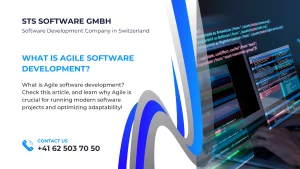I. Introduction
Bespoke software, designed to specifically address the intricate needs of individual businesses, stands as a pivotal asset, delivering unmatched advantages. However, the costs associated with its development warrant a meticulous and strategic management approach to ensure maximum return on investment (ROI).
A. Overview of Bespoke Software Development
Bespoke software development entails the creation of tailored applications or systems to precisely align with the unique operational requirements of a business. Unlike off-the-shelf solutions, bespoke software is customized from scratch, integrating specialized functionalities and features that cater exclusively to the organization’s needs. This tailored approach ensures heightened efficiency, improved productivity, and enhanced scalability, offering a competitive edge in today’s dynamic business landscape.
B. Importance of Maximizing ROI in Software Development Expenses
In the realm of software development, expenses are inevitable, yet they present opportunities for astute investment. The significance of maximizing ROI in these expenses cannot be overstated. Effective management of costs while ensuring the resultant software aligns with business objectives is crucial. It involves striking a balance between budget allocations and the envisioned outcomes, aiming to optimize the cost-to-benefit ratio. By prioritizing ROI, businesses not only justify their expenditure but also foster sustainable growth and innovation.
C. Purpose of the Guide
This comprehensive guide is crafted with a specific aim: to provide actionable insights and strategies for businesses embarking on bespoke software development journeys. It aims to illuminate the intricate facets of managing expenses in such endeavors, emphasizing the significance of a strategic approach towards achieving optimal ROI. Through in-depth exploration and practical advice, this guide endeavors to empower decision-makers and stakeholders with the knowledge needed to navigate the complexities of bespoke software development costs effectively.
II. Understanding Bespoke Software Development
A. Definition and Characteristics of Bespoke Software
At its core, bespoke software represents a personalized solution meticulously designed to cater to distinct business requisites. Its defining hallmark lies in its tailor-made nature, ensuring alignment with the specific needs and workflow of an organization. The inherent flexibility and scalability offered by bespoke software underscore its significance in modern business operations.
B. Advantages and Challenges of Bespoke Solutions
The realm of bespoke solutions offers substantial advantages, particularly in providing a competitive edge by aligning software functionalities precisely with business objectives. Nonetheless, traversing this path introduces its own set of challenges. Budgeting uncertainties loom over projects, exacerbated by the potential for lengthy development cycles. Balancing these advantages with the challenges becomes pivotal in harnessing the full potential of bespoke solutions.
C. Market Trends and Demand for Custom Software
A noteworthy trend in today’s market landscape manifests through the escalating demand for personalized software solutions. The shift towards tailored software underscores the criticality of comprehending the cost dynamics entwined within bespoke software development. This increasing demand necessitates a thorough understanding of the evolving market trends, driving the urgency to manage costs effectively in bespoke software development endeavors.
III. Cost Dynamics in Bespoke Software Development
A. Factors Influencing Bespoke Software Development Costs
The multifaceted nature of bespoke software development costs arises from various influential factors. The complexity of the required functionalities, intricacy of the design, integration needs, and the degree of customization all significantly impact the final expenses incurred. A nuanced understanding of these influencing factors is crucial in projecting and managing the costs associated with bespoke software development.
B. Cost Estimation and Budgeting Strategies
Accurate cost estimation forms the bedrock of effective budgeting in bespoke software development. Employing sophisticated estimation methodologies, such as bottom-up estimating or analogous estimation, aids in generating realistic projections. Additionally, instituting robust budgeting strategies that encompass contingencies for unforeseen complexities or changes during development is imperative for financial prudence.
C. Mitigating Cost Overruns and Optimizing ROI
The propensity for cost overruns looms large in bespoke software development, necessitating proactive measures to mitigate such occurrences. Agile methodologies, meticulous project management, and leveraging scalable development approaches aid in containing costs and ensuring optimal returns on investment. By prioritizing features and functionalities aligned with core business needs, organizations can optimize their ROI from bespoke software development initiatives.
IV. Comprehensive Strategies for Maximizing ROI in Bespoke Software Development
A. Thorough Requirements Gathering and Documentation
The cornerstone of successful bespoke software development lies in meticulous requirement collection and detailed documentation. By engaging stakeholders extensively and comprehensively documenting all specifications, the development team minimizes the chances of rework and costly change requests. This proactive approach not only saves time but also significantly reduces additional expenses incurred due to unforeseen alterations during the development phase.
B. Agile Cost Management Strategies
Embracing agile methodologies goes beyond just efficient software development; it inherently incorporates cost management practices. Through iterative development cycles, teams continuously assess and reassess resource utilization, optimizing processes for cost-effectiveness. This iterative approach ensures that financial resources are allocated judiciously, allowing for greater control over expenses while maintaining the project’s momentum and quality.
C. Feature and Functionality Prioritization
Adopting a Minimum Viable Product (MVP) strategy enables businesses to focus on core features essential for launch while planning for subsequent enhancements. This approach mitigates the burden of excessive initial costs by delivering a functional product that meets immediate needs while allowing for the incorporation of additional features in future iterations. Prioritizing features and functionalities in this manner not only ensures a cost-effective initial release but also facilitates the seamless evolution of the software over time.
D. Emphasis on Quality Assurance and Testing
Investing in a robust quality assurance and testing phase is a proactive measure that can significantly impact the overall project expenses. Rigorous testing practices not only detect and address bugs and issues early in the development cycle but also prevent costly rework and maintenance in the long run. By ensuring the software’s reliability and stability, organizations can avert potential financial losses arising from post-release complications, thereby securing long-term savings and customer satisfaction.
E. Continuous Evaluation and Adaptation
An often overlooked yet crucial aspect of cost management in bespoke software development is the continuous evaluation and adaptation of strategies throughout the project lifecycle. Regular assessment of expenditure against predefined budgets, coupled with a willingness to adapt strategies based on evolving project dynamics, allows for timely course correction. This adaptive approach ensures that financial resources are optimally utilized, minimizing the risk of budget overruns while maintaining the project’s trajectory towards successful completion.
F. Vendor and Resource Management
Efficient management of external vendors and internal resources plays a pivotal role in cost containment. Establishing transparent communication channels, negotiating favorable terms, and optimizing resource allocation contribute significantly to cost efficiency. Moreover, fostering strong relationships with vendors and leveraging their expertise can result in cost-effective solutions and streamlined development processes.
G. Risk Management and Contingency Planning
Anticipating and mitigating risks is fundamental to controlling expenses in bespoke software development. Implementing a proactive risk management strategy involves identifying potential threats to the project’s budget and devising contingency plans to address them. By having mitigation strategies in place, organizations can preemptively tackle unforeseen circumstances, reducing the financial impact and ensuring the project stays on track.
H. Post-Implementation Monitoring and Optimization
The journey towards maximizing ROI doesn’t conclude with software deployment; it extends into post-implementation phases. Continuous monitoring of the software’s performance, user feedback, and market trends facilitates ongoing optimization. This iterative process of refinement not only enhances the software’s capabilities but also identifies opportunities to manage costs better by focusing resources on high-value enhancements and resolving potential inefficiencies.
I. Knowledge Sharing and Continuous Improvement
Encouraging a culture of knowledge sharing and continuous improvement within the development team fosters innovation and cost-effectiveness. Collaborative learning, sharing best practices, and implementing lessons learned from previous projects create an environment conducive to optimized workflows and reduced development costs over time.
V. Delving into Cost Estimation and Budgeting within Tailored Software Projects
A. Varied Approaches to Cost Estimation
Choosing between fixed-price and time-and-material models significantly influences the selection of an appropriate cost estimation methodology. The former offers a predetermined price for the entire project, whereas the latter allows flexibility in pricing based on the resources and time consumed.
B. Strategic Budgeting Approaches
Effective budgeting in tailored software development necessitates meticulous resource allocation, the establishment of contingency plans, and a continuous, vigilant monitoring of expenses. This trifecta ensures the successful navigation of financial constraints and project completion within set financial boundaries.
VI. Risk Management and Mitigation Strategies
A. Identifying and Assessing Risks
In the realm of bespoke software development, identifying potential risks and comprehensively assessing their potential impact on costs forms the cornerstone of effective risk management. Understanding the landscape of common risks within this domain is pivotal. These risks often include but are not limited to:
Technical Risks: These encompass challenges related to technological complexities, system integrations, or evolving frameworks that could impact the development process and timeline, thereby influencing costs.
Resource Risks: These involve issues related to workforce availability, skill shortages, or turnover rates within the development team, potentially affecting project continuity and budget.
Scope Creep: Changes in project scope, whether due to evolving requirements or unclear initial specifications, can significantly impact timelines and costs if not managed effectively.
Security and Compliance Risks: Ensuring adherence to security standards and regulatory compliance throughout the development lifecycle is crucial. Any oversight in this area could lead to costly setbacks or legal repercussions.
B. Risk Mitigation Techniques
Once risks have been identified and understood, the focus shifts to proactive mitigation strategies aimed at reducing their potential impact on expenses and project timelines.
Contingency Planning: Developing comprehensive contingency plans that account for identified risks is paramount. This involves creating alternate approaches or fallback strategies to address unforeseen challenges swiftly and effectively. For instance, having backup technical solutions in place or establishing protocols for rapid resource scaling in case of unexpected turnover.
Flexibility in Execution: Building flexibility into the project execution strategy enables teams to adapt swiftly to changing circumstances. Agile methodologies, for instance, allow for iterative development and continual adjustments based on evolving requirements, reducing the impact of scope creep and other unforeseen changes.
Continuous Monitoring and Adaptation: Regularly monitoring risk factors throughout the development lifecycle and adapting strategies accordingly is vital. This proactive approach enables early identification of potential issues, allowing for timely intervention and mitigation before they escalate into major cost burdens.
Robust Communication and Collaboration: Facilitating open communication channels among team members, stakeholders, and relevant parties fosters a proactive environment for risk identification and resolution. Collaborative efforts often lead to innovative solutions and early detection of potential risks.
Utilization of Prototyping and Testing: Implementing prototyping and rigorous testing methodologies helps in early identification and rectification of potential issues, thereby minimizing the likelihood of costly errors during the later stages of development.
VII. Conclusion
In conclusion, mastering the art of maximizing ROI in bespoke software development involves a comprehensive understanding of cost drivers, strategic planning, and risk mitigation. As technology evolves, the ability to balance innovation with cost-effectiveness will define successful ventures in the realm of custom software development.



